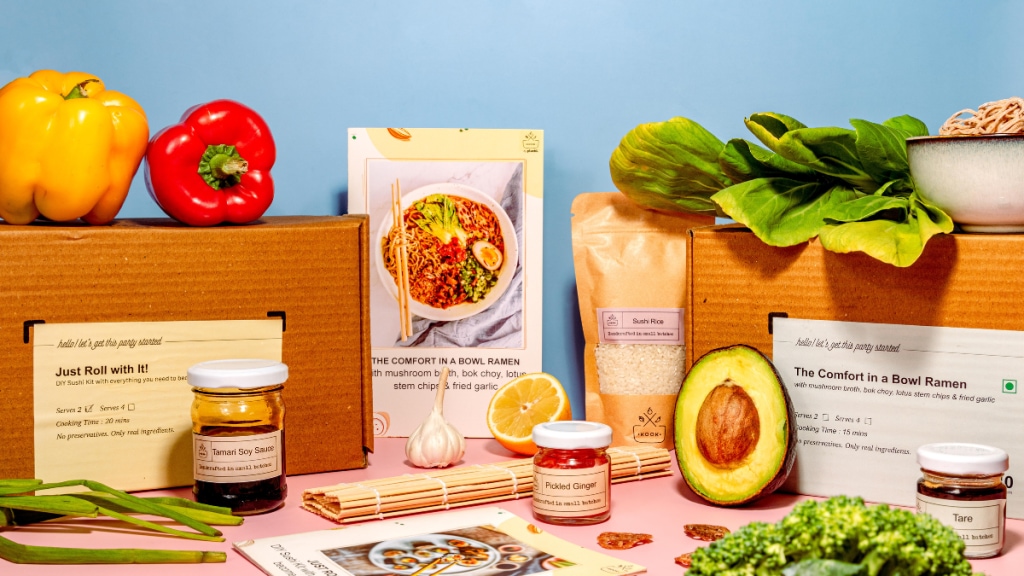If you’re sick of eating takeaway, but also can’t face rustling up your own meal from scratch, why not meet in the middle with a DIY meal kit?
Not impressed? Search online.
Besides LT Foods’ Daawat Biryani Kit, there’s KitFresh by Sanjeev Kapoor (2020), Spicery (2020), iD Fresh Food (2005), KooK (2020), Chefling (2017), all vying for the attention of time-strapped Indians.
Essar-backed Pluckk’s meal kit arm KooK says it is all set to grow four times in FY25. “The concept of ready-to-cook meal kits gained traction during COVID-19, which coincided with Kook’s launch,” says co-founder Arpita Jerath. “With restricted access to house help and a shift in consumer priorities, people became more inclined to cook at home, valuing control over what they consumed.”
Another brand that gained traction after appearing on Shark Tank India is Chefling, which secured `40 lakh investment for a 16% equity from sharks Namita Thapar, Peyush Bansal, Azhar Iqubal, and Amit Jain. The brand offers DIY kits for global favourites such as Japanese sushi, Mexican tacos, and Italian lasagna. Rounit Kashyap Gambhir, founder & MD, says his brand is trying to make cooking a social experience, one where friends, siblings, or cousins can come together to create something.
Since its launch, the company has sold over 5,000 kits across India and generated notable interest among home chefs. By 2024, Chefling’s annual revenue exceeded `1 crore.
While this concept took off over a decade ago in Europe and America, RTC meal kits are relatively new in the country. As per GlobalData, the meal kits market in India registered a positive compound annual growth rate of 15% during 2018 to 2023 with a sales value of `21 crore in 2023, an increase of 14% over 2022. The market achieved its strongest performance in 2020, when it grew by 18% over its previous year.
So what will it take for the market to really take off? Experts say they must address key consumer concerns first. “Meal kits face challenges such as premium pricing, fresh logistics, consumer education, and sustainability concerns,” says Anand Ramanathan, partner, consumer products and retail sector leader, Deloitte India.
To address price concerns, Ramanathan suggests firms target urban professionals, offer discounted subscriptions, or create family-sized kits to lower costs. “To ensure freshness in a climate-sensitive market requires partnerships with local suppliers, urban micro-warehouses, and seasonal menus to cut transportation costs. Educating consumers on the benefits through marketing campaigns, highlighting convenience, health, and culturally relevant recipes, can enhance adoption,”he adds.
Ajimon Francis, managing director, Brand Finance India, says meal kit brands need “huge investments to establish sustainable supply chains” to survive in the long term.
For Angshuman Bhattacharya, partner and national leader, consumer product and retail sector, EY-Parthenon, customer experience is key. “RTC meal kit brands would see greater traction if they prioritise fresh food over frozen or long shelf-life options, as past industry attempts have shown.” He also emphasises the importance of scalability. “Previous efforts, such as Tata’s and ITC’s, have pivoted from meal kits to sauces, seasonings, and purees. Frozen options like chicken popcorn and French fries continue to grow in popularity due to their taste and convenience.
Balancing taste, localisation, and having the right distribution model remain key to the segment’s success,” adds Bhattacharya.
For the time being, meal kits will remain niche, catering to a select segment of customers who are ‘counting’ and ‘measuring’ what they are eating.
